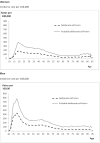Incidence Rates of Deliberate Self-Harm in Denmark 1994-2011
- PMID: 27278571
- PMCID: PMC5137321
- DOI: 10.1027/0227-5910/a000391
Incidence Rates of Deliberate Self-Harm in Denmark 1994-2011
Erratum in
-
Correction to Morthorst et al., 2016.Crisis. 2016 Jul;37(4):316. doi: 10.1027/0227-5910/a000431. Epub 2016 Jun 24. Crisis. 2016. PMID: 27338293 No abstract available.
Abstract
Background: The validity and reliability of suicide statistics have been questioned and few nationwide studies of deliberate self-harm have been presented.
Aim: To calculate rates of deliberate self-harm in Denmark in order to investigate trends and assess the reliability of hospital records.
Method: A register study based on all individuals recorded with an episode of deliberate self-harm or probable deliberate self-harm in nationwide registers during 1994-2011.
Results: A substantial difference in the rates of deliberate self-harm and probable deliberate self-harm was noted for both genders. The average incidence rate of deliberate self-harm for women and men was 130.7 (95% CI = 129.6-131.8) per 100,000 and 86.9 (95% CI = 86.0-87.8) per 100,000, respectively. The rates of deliberate self-harm for women increased from 137.6 (95% CI = 132.9-142.3) per 100,000 in 1994 to 152.7 (95% CI = 147.8-157.5) in 2011. For a subgroup of younger women aged 15-24 years, an almost threefold increase was observed, IRR = 2.5 (95% CI = 2.4-2.7). The most frequently used method was self-poisoning.
Conclusion: The rates of deliberate self-harm and probable deliberate self-harm differed significantly. An increased incidence of deliberate self-harm among young Danish women was observed, despite detection bias. An improved registration procedure of suicidal behavior is needed.
Keywords: deliberate self-harm; hospital records; incidence rates; nationwide; suicidal behavior.
Figures




References
-
- Alander S. W., Dowd M. D., Bratton S. L., & Kearns G. L. (2000). Pediatric acetaminophen overdose: Risk factors associated with hepatocellular injury. Archives of Pediatrics & Adolescent Medicine, , 346–350. - PubMed
-
- Bergen H., Hawton K., Waters K., Cooper J., & Kapur N. (2010). Epidemiology and trends in non-fatal self-harm in three centres in England, 2000 to 2007. British Journal of Psychiatry, , 493–498. - PubMed
-
- Bertolote J. M., & Fleischmann A. (2005). Suicidal behavior prevention: WHO perspectives on research. American Journal of Medical Genetics Part C: Seminars in Medical Genetics, , 8–12. - PubMed
-
- Bertolote J. M., & Fleischmann A. (2009). Suicide thoughts, suicide plans and attempts in the general population on different continents In Wasserman D. & Wasserman C. (Eds.), The Oxford textbook of suicidology and suicide prevention: A global perspective, (pp. 99–104). Oxford, UK: Oxford University Press.
MeSH terms
LinkOut - more resources
Full Text Sources
Other Literature Sources
Medical

